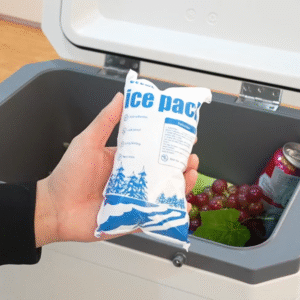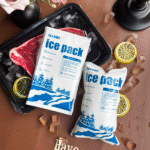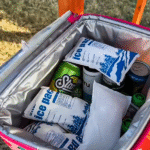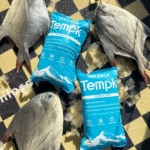Ladrillos de hielo seco vs.. Paquetes de hielo seco: cuál es mejor para enviar productos congelados?
Al enviar productos perecederos como mariscos, productos farmaceuticos, o muestras biotecnológicas, Mantener una cadena de frío óptima es crucial. Ambos ladrillos de hielo seco y bolsas de hielo seco son soluciones sólidas de CO2, ideal para conservar artículos a temperaturas bajo cero. Pero, ¿cómo eliges la mejor opción para tus necesidades específicas en 2025? En esta guía, compararemos las características, beneficios, y aplicaciones de bloques de hielo seco versus paquetes de hielo seco y brindar recomendaciones de expertos para ayudarlo a tomar una decisión informada..
-
¿Qué son los ladrillos de hielo seco y las bolsas de hielo seco?, y como funcionan?
-
¿Cómo se selecciona la mejor solución de hielo seco para su envío??
-
¿Qué beneficios ofrecen los ladrillos de hielo seco sobre las bolsas de hielo tradicionales??
-
¿Cómo se garantiza el cumplimiento de las normas de envío cuando se utiliza hielo seco??
-
¿Cuáles son las últimas tendencias e innovaciones en el envío de hielo seco para 2025?
¿Qué son los ladrillos de hielo seco y las bolsas de hielo seco??
Ladrillos de hielo seco:
Los ladrillos de hielo seco son grandes., bloques sólidos de CO2 congelado, Diseñado para proporcionar duraciones de enfriamiento extendidas durante envíos de larga distancia.. Estos ladrillos son ideales para envíos que requieren entre 48 y 72 horas o más de enfriamiento., como por ejemplo para productos biológicos, mariscos congelados, y productos farmacéuticos. La lenta tasa de sublimación de los ladrillos de hielo seco garantiza que las mercancías dentro del envío permanezcan congeladas durante períodos más prolongados..
Paquetes de hielo seco:
Las bolsas de hielo seco están preenvasadas., láminas flexibles o bloques de hielo seco. Estos paquetes suelen ser más pequeños y están diseñados para envíos de menor duración. (12–48 horas). Se utilizan comúnmente para envíos pequeños o para artículos que deben enfriarse en lugar de congelarse., como chocolates, productos cosméticos, o pequeños paquetes farmacéuticos. Las bolsas de hielo seco son más fáciles de manejar y más adaptables a varios tamaños de paquetes..
¿Cómo se comparan los ladrillos y los paquetes de hielo seco??
| Característica | Ladrillos de hielo seco | Paquetes de hielo seco |
|---|---|---|
| Duración del enfriamiento | Arriba a 72 horas o más | Normalmente entre 12 y 48 horas |
| Manejo | Requiere guantes; más pesado, más voluminoso | Más fácil de manejar; ligero |
| Costo | Generalmente más caro | Más asequible |
| Uso ideal | Envíos de larga distancia, grandes volúmenes | Envíos de corta distancia, pequeños volúmenes |
| Regulaciones | Debe cumplir con las leyes de envío de materiales peligrosos. | Debe cumplir con las leyes de envío de materiales peligrosos. |
Cómo seleccionar la mejor solución de hielo seco para su envío
Consideraciones clave:
-
Duración del envío:
-
Para envíos de larga distancia (encima 48 horas), Los ladrillos de hielo seco son la mejor opción debido a su mayor duración de enfriamiento..
-
Las bolsas de hielo seco son ideales para envíos que requieren refrigeración por hasta 48 horas o menos.
-
-
Tipo de bienes:
-
Los productos sensibles, como vacunas o productos biológicos, que requieren temperaturas bajo cero durante períodos prolongados, deben enviarse con bloques de hielo seco..
-
Para productos como chocolates, kits de comida, o cosméticos que sólo necesitan permanecer fríos, Las bolsas de hielo seco son suficientes..
-
-
Requisitos de embalaje y espacio:
-
Los envíos más grandes con mercancías más voluminosas se benefician de los ladrillos de hielo seco, mientras que las bolsas de hielo seco son más adecuadas para paquetes más pequeños.
-
-
Sensibilidad a la temperatura:
-
Las bolsas de hielo seco son perfectas para productos que no requieren temperaturas de congelación extremas pero que deben permanecer fríos por un período corto..
-
Los ladrillos de hielo seco brindan un enfriamiento más constante y son más adecuados para artículos críticos que deben mantenerse congelados durante el tránsito..
-
¿Cuáles son los beneficios de los ladrillos de hielo seco sobre las bolsas de hielo tradicionales??
Ventajas de los ladrillos de hielo seco:
-
Duración de enfriamiento más larga: Los ladrillos de hielo seco mantienen temperaturas bajo cero hasta por 72 horas, significativamente más largo que las bolsas de hielo tradicionales, que normalmente duran sólo 12-24 horas.
-
Sin daños por agua: Las bolsas de hielo tradicionales se derriten en agua, productos potencialmente dañinos. El hielo seco se sublima en gas, No dejando líquido atrás.
-
Ideal para envíos críticos: Los ladrillos de hielo seco son la opción preferida para envíos de productos perecederos, productos farmaceuticos, y muestras biotecnológicas que requieren consistente, enfriamiento a largo plazo.
Ejemplo de la vida real:
Una empresa de biotecnología que envía vacunas sensibles a la temperatura desde EE. UU.. a Europa utilizó ladrillos de hielo seco para garantizar que los productos permanecieran congelados durante todo el viaje de 48 horas, mientras que el hielo tradicional se habría derretido, comprometer la integridad del envío.
Cómo garantizar el cumplimiento de las normas de envío de hielo seco
Para garantizar un transporte seguro y legal, Los envíos de hielo seco deben cumplir tanto con los Departamento de Transporte (PUNTO) y Asociación Internacional de Transporte Aéreo (IATA) regulaciones.
Regulaciones clave:
-
Embalaje adecuado: El hielo seco debe empaquetarse en contenedores que permitan que el gas CO2 escape para evitar la acumulación de presión..
-
Requisitos de etiquetado: Los envíos que contengan hielo seco deben estar marcados con la etiqueta “Dióxido de carbono sólido” e indicar el peso del hielo seco..
-
Límites de peso: Para transporte aéreo, El hielo seco se limita a 5.5 libras (2.5 kilos) por paquete, pero este límite puede variar según el transportista y la ruta..
2025 Tendencias e innovaciones en el envío de hielo seco
El sector logístico de la cadena de frío evoluciona continuamente con los avances tecnológicos. En 2025, Varias innovaciones están mejorando la eficiencia y la sostenibilidad de los envíos de hielo seco.:
Soluciones de embalaje inteligentes:
-
Los sensores de IoT integrados en los paquetes de hielo seco permiten el monitoreo de la temperatura en tiempo real, Asegurar que el envío permanezca dentro del rango de temperatura requerido durante todo el viaje..
-
Los contenedores de hielo seco reutilizables y los materiales de embalaje ecológicos son cada vez más comunes, Apoyar la sostenibilidad y reducir los costos operativos..
Sostenibilidad en el transporte con hielo seco:
-
Existe una creciente demanda de recubrimientos biodegradables en envases de hielo seco., que ayudan a reducir el impacto ambiental y alinearse con regulaciones de sostenibilidad más estrictas.
Logística impulsada por IA:
-
Los sistemas de inteligencia artificial ahora están optimizando la cantidad de hielo seco utilizado en función de las condiciones de envío., lo que reduce el desperdicio y garantiza que los envíos se mantengan a la temperatura ideal sin embalaje excesivo.
Cómo manipular y empaquetar hielo seco de forma segura
El embalaje y la manipulación adecuados del hielo seco son esenciales para garantizar tanto la seguridad de las mercancías que se envían como el bienestar de las personas que las manipulan.. El hielo seco está clasificado como material peligroso debido a los riesgos asociados con la acumulación de dióxido de carbono y el frío extremo..
Consejos clave para empacar:
-
Use contenedores ventilados: Asegúrese de que el contenedor esté ventilado para permitir que escape el gas CO2., prevenir la acumulación de presión.
-
Capa de hielo seco: Al empacar, Coloque hielo seco en la parte superior del envío., A medida que el aire frío se hunde. Además, use aislamiento para disminuir la velocidad de sublimación y mantener temperaturas estables.
-
Etiquete los paquetes correctamente: No olvide marcar claramente el envío con las etiquetas correctas de hielo seco y materiales peligrosos según lo exigen las regulaciones..
Consejos de seguridad:
-
Usar guantes protectores: Manipule siempre el hielo seco con guantes aislantes para evitar la congelación..
-
Ventilar el área de envío: Asegúrese de que el espacio donde se almacena el hielo seco esté bien ventilado para evitar que se acumule CO2..
Conclusión y recomendaciones
La elección entre bloques de hielo seco y bolsas de hielo seco depende de varios factores, incluyendo la duración del envío, el tipo de mercancías que se transportan, y los requisitos reglamentarios. Los ladrillos de hielo seco son ideales para largas distancias., Envíos sensibles a la temperatura, mientras que las bolsas de hielo seco son más adecuadas para el enfriamiento a corto plazo.
Siguientes pasos:
-
Evalúa tus necesidades: Determinar la duración y el tipo de envío para elegir entre bricks y packs de hielo seco.
-
Garantizar el cumplimiento: Asegúrese de que su embalaje cumpla con las regulaciones DOT e IATA, y utilizar el etiquetado correcto.
-
Optimizar para la sostenibilidad: Considere invertir en bolsas de hielo seco reutilizables e integrar sensores de IoT para rastrear la temperatura durante todo el viaje..
Acerca de Tempk
Y tempk, Nos especializamos en logística de cadena de frío., ofreciendo soluciones de hielo seco de alta calidad, incluyendo ladrillos y paquetes, para garantizar el transporte seguro y eficiente de productos sensibles a la temperatura. Nuestra experiencia en cumplimiento, sostenibilidad, y la innovación nos convierte en un socio confiable para industrias que van desde la farmacéutica hasta la del marisco.. Póngase en contacto con Tempk hoy para optimizar sus necesidades de envío de cadena de frío.
Llamado a la acción:
Para asesoramiento experto y soluciones personalizadas para la cadena de frío, Consulte con Tempk hoy y explore cómo nuestras soluciones avanzadas de hielo seco pueden optimizar sus procesos de envío..
























